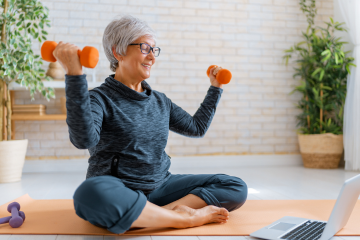Managing Menopause
The Importance of Exercise for Peri-Menopausal and Menopausal Women
Liz Barry, Deputy Physiotherapy Manager, CUH/CUMH
Menopausal symptoms can include difficulty sleeping, brain fog, hot flushes, mood changes, headaches, joint pains, low sex drive, vaginal dryness and bladder problems.
Exercise can be very beneficial for perimenopausal (the years leading up to menopause), menopausal and post-menopausal( the years after periods have stopped) women.

- It can reduce the risk of heart disease - with the decrease in the hormone oestrogen women have the same risk of heart disease as men. Exercise can help to maintain healthy blood pressure and cholesterol levels as well as reduce the risk of heart attack and stroke.
- It can help maintain bone density and reduce the risk of osteoporosis and bone fractures.
- It can help to reduce body fat and maintain a healthy body weight. This reduces the risk of developing Type 2 Diabetes and some cancers such as breast, colon and endometrial cancer
- It helps to improve your mood and can help reduce stress.
There are two types of exercise which should be undertaken
1. Muscle Strength training
Adults over the age of 50 experience a more rapid loss of muscle mass called sarcopenia. Therefore muscle strength training is really important to maintain muscle mass. Strength training also helps to stimulate bone density which is affected by the lack of oestrogen experienced during the menopause.
- Strength training should be done at least twice per week.
- Strength training doesn’t have to involve going to the gym and lifting weights or using resistance machines. It can be done in a class or at home.
- It could be a pilates or yoga class where you are using your body weight or weight of your limbs as resistance.
- It could be a home workout. An example of this would be the RTE Operation Transformation exercise programme prescribed for participants which requires no special equipment. The HSE also have examples of strength training and balance training that can be done at home.
- If you do choose to go to a gym and you are not familiar with exercising in a gym setting, use the guidance of a qualified personal trainer with experience in training older women.
2. Cardiovascular Training
For a healthy heart and circulation, it is recommended that adults aged 19-64 do at least 150 minutes of moderate-intensity exercise or 75 minutes of vigorous-intensity exercise per week.
- Moderate intensity means you are slightly out of breath but can maintain a conversation. This can include brisk walking, hiking, cycling, aquaerobics, dancing or doubles tennis.
- Vigorous exercise is when it is difficult to maintain a conversation while you exercise. Examples include jogging, swimming, skipping, tennis, and team sports such as camogie, football, basketball and soccer.
If this seems daunting and you don’t undertake any regular exercise at the moment, start small. Something is better than nothing. Start with a 10-minute walk 3 days per week and gradually increase this over several weeks. If you already walk regularly try jogging for the last 60 seconds of your walk to stimulate your bones and increase your heart rate. Try to increase this over time.
Top tips for exercising
- Consistency is key so always pick an exercise you enjoy as you will be more motivated to do it and feel good after it
- Try exercising with a friend, family member or group to help keep you accountable.
- Plan your exercise so that it becomes part of your daily routine. Build it onto an existing habit. For example perform 10 squats, 10 calf raises and 10 biceps curls using a water bottle or lightweight as resistance while you wait for the kettle to boil. Leave your weight beside the kettle to remind you to do it. Incorporate your walk as part of your daily commute to work
- Keep breathing while you exercise – holding your breath, breathing in a shallow manner or pulling in your tummy muscles while you exercise increases pressure on your pelvic organs and doesn’t allow your pelvic floor muscles to work effectively to support them.
- Wear comfortable clothing and footwear. Layers are good as you can remove them as you warm up. Pick material that is light and can absorb the moisture from when you sweat
- If you experience any issues with bladder or bowel control or have a feeling of heaviness in the vagina when exercising please speak to your GP. They may offer you advice and/or refer you to a Gynaecologist and/or refer you to a registered physiotherapist with specialist experience in treating pelvic floor problems.
For further information on menopause click here.
Download the Free Balance app to your device or smartphone
Read “Preparing for the Perimenopause and Menopause” by Dr. Louise Newson

